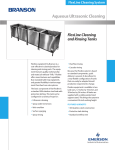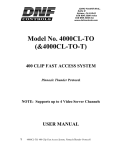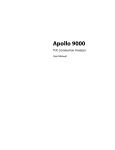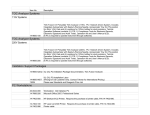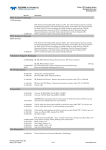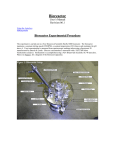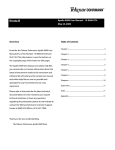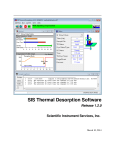Download Recommended Maintenance for the Eclipse
Transcript
Recommended Maintenance for the Eclipse September 2007 www.oico.com Overview • Routine Maintenance – Daily Maintenance – Weekly Maintenance – Monthly Maintenance – Quarterly Maintenance – Yearly As-Needed Maintenance • Maintenance Review • Summary Routine Maintenance • It is important to do routine maintenance on your Eclipse Purge-and-Trap Sample Concentrator. • Doing routine maintenance will: – Optimize instrument performance and improve results – Minimize downtime and expense for repairs – Lengthen the overall lifetime of your instrument • Most of the procedures described here can be easily and quickly performed by the instrument operator. – Described in the Eclipse manual • Keep a log of your maintenance as a reference for when problems do arise. Daily Maintenance 99999 99999 99999 99999 Daily Maintenance • The daily maintenance on the instrument is the single most important thing you can do to ensure optimum performance and uninterrupted operation of your Eclipse. • Daily maintenance will help identify and correct conditions before they develop into serious problems. Daily Maintenance Overview • Trap conditioning • Inspect the sparger frit • Monitor the system pressure (during Purge) • Inspect connections • Review the run logs • Inspect IS/SS and pressure in standard vessels • Prime and monitor the SAM rotor • Replenish the water reservoir • Monitor one sample transfer • Inspect the needle and needle-toloop transfer line • Monitor BFB tune check • Monitor blanks • Monitor the CCV Daily Maintenance • Trap Conditioning – Condition the trap on a daily basis immediately prior to running samples. – This can be done while the BFB tune check sample is running or while preparing the QC samples for the day to save time. – The automated procedure uses time and temperature parameters from Bake step of active Method. – The parameters can be over-written if desired. – Condition a new trap prior to analysis or bake an older trap if contamination is suspected. Daily Maintenance: Eclipse Trap Conditioning • Trap Conditioning (cont.) – Maintenance page, Trap Condition icon • User specified time and temperature • Fully automated • Auto-fills the time & temp with Active Method parameters Daily Maintenance (cont.) • Inspect the sparger frit – Visually inspect the sparger frit for signs of contamination or plugging from dirty samples. • Monitor the system pressure (during Purge) – Monitor the system pressure during purge for signs of increasing pressure. – Should be about 8–12 psi during purge, depending on trap type and age. • Inspect Connections – Visually inspect all connections at transfer lines and valves for signs of liquid leakage or corrosion. System pressure during Purge Daily Maintenance (cont.) • Review the Run Logs – Review electronic run log for “Foam Sensor” tripped or “Sparge Overfill Sensor” tripped. – This can indicate problems with valves, potential contamination, etc. • Inspect IS/SS and Pressure of Standard Vessels – Visually inspect level of IS/SS. – Inspect pressure of standard vessels. Daily Maintenance (cont.) • Prime and Monitor the SAM Rotor – Prime the SAM rotor daily – Monitor for blockage in the line • Replenish the Water Reservoir – Add clean water as necessary. • Monitor One Sample Transfer – Visually monitor the transfer of at least 1 sample each day. – Watch for proper loop filling, complete sample transfer, leaks, function of AS pump or syringe, etc. Daily Maintenance (cont.) • Inspect the needle and needle-to-loop transfer line – Visually inspect for signs of wear or breakage. • Monitor BFB tune check – Monitor daily for MS performance. • Monitor blanks – Monitor daily for contamination. • Monitor the CCV – Monitor for development of problems with specifically difficult compounds. Weekly Maintenance 9 9 9 9 Weekly Maintenance Overview • Leak check • Check the purge flow rate Weekly Maintenance • Leak Check – Leak check the system weekly to monitor for developing leaks or increases in system pressure. • Run on the first day of the week (or another regularly scheduled day) • Maintenance page, Leak Tests icon • “Through Sparger” choice is usually sufficient • “Full” can be selected if a leaky Dry Purge valve (B) is suspected Weekly Maintenance (cont.) • Leak Check (cont.) – Leak Check Failure • Indicates a leak in the system • Will lead to loss of analytes and poor recoveries • Must be repaired before analyzing samples – An increase in system pressure could indicate an aging trap or an obstruction in the sample pathway (e.g. at the foam filter). Weekly Maintenance: Automated Leak Test Perform automated system leak check by pushing one button. Checks with and without trap in line. Weekly Maintenance (cont.) • Check the purge flow rate – Check the purge flow rate immediately after running the leak test procedure. – Procedure: • Add 5 mL of DI water to the sparge vessel • From the Maintenance page step the instrument to Purge • Measure the flow rate out the Purge vent on the front of the instrument – The purge flow rate should be 35–40 mL/min. Monthly Maintenance 9 Monthly Maintenance Overview • Backflush the sample pathway with methanol • Check the bake flow rate Monthly Maintenance • Backflush the Sample Pathway with Methanol – Set instrument to Standby – Turn off power and unplug – Remove trap – Use tool and syringe to backflush pathway with methanol – Collect methanol in sparger – Remove methanol from sparger with syringe – Repeat 2–3 times – Install blank trap and bake system See instruction sheet for full details on rinsing procedure Monthly Maintenance (cont.) Methanol is removed from the sparger using the syringe and the 4-port valve on top of the sparge mount. Monthly Maintenance (cont.) • Check the bake flow rate – Procedure: • From the Maintenance page, step the instrument to Bake • Measure the flow rate out the Bake vent on the front of the instrument – The bake flow rate should be approximately 80– 120 mL/min. – The bake flow rate can also be checked while conditioning the trap. Quarterly Maintenance 9 Quarterly Maintenance Overview • New analytical trap • Water management fitting • Clean dust and dirt • Confirm operation of fans, valves, and heated zones • Reset counters • Disconnect and rinse the transfer line Quarterly Maintenance • New analytical trap – Install and condition a new analytical trap. • The frequency of changing the analytical trap will depend on how many samples are run and how dirty or contaminated they are • With “average” use, change the trap quarterly to maintain optimum performance – A lab running samples 24 hours a day, 7 days a week and running dirty samples may need to change the trap more frequently, even monthly. – Leak test the system and condition the new trap after it has been installed. – In some cases, you may need to re-calibrate after installing a new trap. Quarterly Maintenance (cont.) • Water Management Fitting (WMF) – Remove and sonicate or replace the Water Management Fitting (WMF) and tubing assembly between WMF and 6-port valve. – The WMF and tubing assembly are considered consumable items. • Ni plating can degrade overtime, especially with dirty samples and continuous heating/cooling cycles – The WMF and tubing assembly are the only two pieces of the sample pathway that are in contact with the sample during both Purge and Desorb. Quarterly Maintenance (cont.) • Water Management Fitting (WMF) (cont.) – The WMF can be removed, sonicated, and baked quarterly to recondition it. • Can be sonicated 1 to 3 times to recondition before replacing • Will have to be replaced periodically – Also do this any time you observe drop in response or other analytical problems with the polar, or water-sensitive compounds. • Alcohols, ketones, ethers • Brominated compounds • Heavy compounds (last four on the list) Quarterly Maintenance: Cyclone WMF • Water Management Fitting (cont.) – Turn off power to the instrument and unplug – Remove the trap and retaining nut (trap side) – Remove the tubing assembly from the WMF to the 6-port valve – Remove WMF, being careful not to break the thermocouple and heater cables – NOTE: Always sonicate or replace the tubing assembly between the WMF and the 6-port valve at the same time! Quarterly Maintenance (cont.) • Clean dust and dirt – Clean any accumulated dust and dirt on the fans and vents. – Clean any accumulated dust and dirt on the screen below the WMF. • Fans, valves, and heated zones – Confirm operation • Counters – Reset as necessary • Transfer line – Disconnect and rinse Yearly Maintenance 9 Yearly Maintenance • Complete Preventative Maintenance (PM) – Once a year, the service engineer should perform a complete Preventative Maintenance on the system – Interview user for any problems or difficulties – Review instrument log file for error conditions – Inspect entire system for signs of wear, obviously broken parts, or other issues – Clean and remove any accumulated dust or dirt on vents, fans, and screens and reset counters – Check/confirm operation of all fans, valves, and heated zones and replace as necessary Yearly Maintenance (cont.) • Complete Preventative Maintenance (cont.) – Replace all pieces in the sample pathway • Sparger • Tubing assemblies • Water management fitting • Trap and trap bulkhead fitting • Transfer line to the GC – Perform a leak check of the system – Run a clean blank sample and BFB tune check sample – Run a mid-point calibration sample to confirm good chromatography and appropriate response for all compounds “As Needed” Maintenance 9 9 9 “As Needed” Maintenance Overview • Trap conditioning • Leak check • Backflush the sample pathway “As Needed” Maintenance • Trap conditioning – Condition the trap when first installed in the instrument – Trap conditioning can also be done any time that contamination or carry-over is observed • TRAP CONDITION icon for simple or routine conditioning • PURGE/BAKE icon for more thorough cleaning with programmable number of cycles • BAKEOUT icon for serious contamination raises temperatures of all heated zones and runs through P&T cycle multiple times • Leak check – Leak check the system any time the system has been open to atmosphere (e.g. to change the trap) – Leak check any time analytical results show a loss of light compounds “As Needed” Maintenance (cont.) • Backflush the sample pathway – Backflush with methanol any time analytical results indicate a problem with polar compounds, brominated compounds, or heavy compounds at the end of the chromatogram – If this does not correct the problem, you may need to sonicate/bake the WMF and tube assembly or completely replace them Summary of Daily Maintenance Daily 99999 99999 99999 99999 • Trap conditioning • Inspect the sparger frit • Monitor the system pressure (during Purge) • Inspect connections • Review the run logs • Inspect IS/SS and pressure in standard vessels • Prime and monitor the SAM rotor • Replenish the water reservoir • Monitor one sample transfer • Inspect the needle and needle-toloop transfer line • Monitor BFB tune check • Monitor blanks • Monitor the CCV Summary of Weekly Maintenance • Leak check Weekly 9 9 9 9 • Check the purge flow rate Summary of Monthly Maintenance Monthly 9 • Backflush the sample pathway with methanol • Check the bake flow rate Summary of Quarterly Maintenance • New analytical trap Quarterly • Water management fitting • Clean dust and dirt 9 • Confirm operation of fans, valves, and heated zones • Reset counters • Disconnect and rinse the transfer line Summary of Yearly Maintenance Yearly • Schedule a visit from your OI service engineer for a yearly Preventative Maintenance (PM) call. • 1-800-336-1911 9 Summary • For optimum performance and minimal downtime of your Eclipse, perform all routine maintenance on a regular schedule. • All of the procedures recommended here are described in the Eclipse user manual and can be easily and quickly performed by the instrument operator. • Keep a log of your maintenance. • For assistance with any of these procedures, contact the OI Analytical Technical Support Department at 1-800-336-1911. 3065pres












































